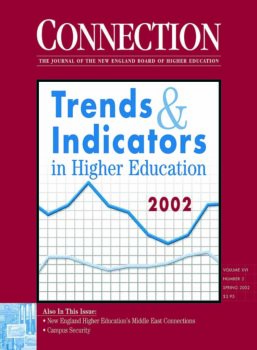 In 1966, Jimmy Ruffin sang “What Becomes of the Brokenhearted?” This song resonates with us and many of our colleagues whose hearts were broken 55 years ago at our alma mater, Springfield College …
In 1966, Jimmy Ruffin sang “What Becomes of the Brokenhearted?” This song resonates with us and many of our colleagues whose hearts were broken 55 years ago at our alma mater, Springfield College …
Virtually every Black student at the college in those days felt unwelcomed. Not only was there a dearth of Black faculty, but there were also virtually no administrators of color and no support services to address the needs of the dozen Black students on campus.
This was a time when Muhammad Ali refused the military draft. The Reverend Dr. Martin Luther King, Jr. was assassinated. John Carlos and Tommy Smith raised their fists in a Black Power salute at the 1968 Olympics. Students of color throughout the country were demonstrating for equality and fair treatment on their campuses. These epochal events were not lost on Black students at Springfield College. In 1969, we took over the administration building and the following year occupied a dormitory. As a result, virtually all of those who participated in the dormitory takeover were suspended from the college. Brokenhearted, most of them walked away from Springfield College not to be heard from again for 50 years.
A half-century later, I observed the racial tumult of 2020 and reflected on our experience in the 1960s. For it was then that I had an idea. I would check with a few of my sisters and brothers with whom I had shared this undergraduate experience. I began making calls asking if they would reach out to others to see if there was any interest in a Zoom conference call to generally catch up on their life journeys and to ask them how they felt about today’s Springfield College. To my surprise, everyone who was called wanted to meet. I was ecstatic.
Through the process of making calls about a possible reconnect, I and others learned that while Springfield College now has more than 300 Black and Brown full-time undergraduates, these students still have issues that demand attention from the college. These are issues that have frustrated Black students dating back to the days when there were only a handful of Black students, and virtually no Brown students at all on campus. So, in March 2020, my brother and sister alumni began meeting with current leaders of BIPOC (Black, Indigenous, People of Color) students. We decided that to support BIPOC students and influence change at the college, we needed to create a formal group. Hence, the Legacy Alumni of Color of Springfield College was born.
Out of a burning concern to ensure a better experience for Springfield College BIPOC students, our group decided to set up five committees focused on: Mentoring, Public Safety/Student Relations, Coaching/Faculty, Day of Diversity, and Distinguished Alumni. Each committee developed a plan of action in their respective areas. Based on committee input, the Legacy Alumni, in turn, crafted an 18-page report entitled: “Legacy Alumni of Color: A Blueprint for Change” and sent it to the president of the college, Mary-Beth A. Cooper. Responses to all of our recommendations were soon forthcoming. Overwhelmingly, the Legacy Alumni were pleased with the college’s responses to our recommendations.
Listed below are just a few of the recommendations made by the Legacy Alumni of Color. (Please be sure to visit the links for details on some of these initiatives.)
1. Increase ethnic diversity on the senior leadership team to set an example for the college.
2. Build a pipeline to develop BIPOC students for positions in administration, teaching and coaching.
A. Begin with programs for middle school and high school BIPOC students.
B. Conduct a college-sponsored summer institute to develop BIPOC candidates.
C. Continue the mentorship work begun by the Alumni Office.
D. Continue work with NCAA initiatives on diversity and inclusion.
• Have coaches review the 2020 NCAA Inclusion Summer Series and past Equity and Inclusion Forums.
• Have the college sign the Eddie Robinson Rule to ensure that departments of athletics pledge to “interview at least one, preferably, more than one, qualified racial and ethnic minority candidate” for open head coaching jobs.
• Continue participation in the NCAA Ethnic Minority and Women’s Internship program.
• Participate in upcoming NCAA programs to advance racial equity.
3. Improve recruitment of BIPOC students by increasing the diversity of staff in the Office of Undergraduate Admissions.
4. Increase staff and provide adequate funding for the Office of Multicultural Affairs in order to continue the important work of the office to create an inclusive campus, support BIPOC students and address issues of social justice.
5. Include the Office of Multicultural Affairs on tours when prospective students visit the campus.
6. Ensure that members of underrepresented groups are included on all hiring committees.
7. Hire a person of BIPOC descent in the Counseling Center.
8. Hire a person of BIPOC descent in the Office of Spiritual Life.
9. Continue to archive oral histories of BIPOC student experiences at Springfield College.
10. Strengthen ties with the off-campus community by sponsoring and hosting activities and events.
A. Support community service currently conducted by student-run organization such as Women of Power’s supply drive for the YWCA.
B. Increase ties to Springfield’s very active Black religious community.
C. Recruit BIPOC students from Springfield’s middle and high school for on-campus events.
D. Continue to send college staff to provide technical assistance to off-campus community groups.
11. Conduct an annual climate-of-life survey to learn what the experience has been for BIPOC students.
12. Require all entering students take the newly created course in ethnic studies beginning in the fall 2021.
13. Increase funding for existing student-run associations that support BIPOC students. Provide seed money to launch new student-generated associations.
A. Adequately fund the Men of Excellence program to empower men through development of leadership skill, pride and humility
B. Support the Student Society for Bridging Diversity, originally created as the African American Club in the 1980s, to recognize and accept all members of the human race.
C. Support women on campus and in the community through Women of Power group.
14. Make A Day to Confront Racism an annual event to address power, privilege and prejudice. Allocate sufficient funds to engage a speaker with standing equal to that of Ibram X. Kendi, this year’s speaker.
15. Continue the work of the Committee on Public Safety to reduce tension and misunderstanding in interactions between BIPOC students and Public Safety Staff (PSS).
A. Provide name badges for all PSS.
B. Conduct twice yearly dialog groups between BIPOC students and PSS.
C. Complete evaluation sheets following these dialogs to set the agenda for further work.
D. Continue anti-bias training for PPS staff.
16. Prominently display recognition of distinguished BIPOC alumni.
17. Ensure continued progress by issuing a twice annual scorecard on measurable progress made on these and other recommendations emanating from the “Legacy Alumni of Color: A Blueprint for Action” report and continuing feedback.
We believe the Legacy Alumni of Color has done something at Springfield College that no other school in the nation has done. We returned to our alma mater to help fashion a welcoming, inclusive environment for students of all racial and ethnic backgrounds.
So, that’s what became of these brokenhearted. Not a bad outcome, not a bad start.
Donald Brown is the former chair of the Legacy Alumni of Color of Springfield College and the president & CEO of Brown and Associates Education and Diversity Consulting and former director of the Office of AHANA Student Programs at Boston College. Sherry Earle is a member of the Legacy Alumni of Color of Springfield College and a teacher of gifted children in Newtown, Conn.
Editor’s Note: Donald Brown wrote “What Really Makes a Student Qualified for College? How BC Promotes Academic Success for AHANA Students” for the Spring 2002 edition of NEJHE‘s predecessor, Connection: The Journal of the New England Board of Higher Education.
[ssba]
